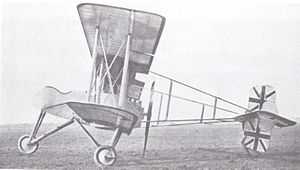Breguet Bre.4
This article is about an aircraft of World War I. For the pre-war design of the same designation, see Breguet Type IV.
| Bre.4 | |
|---|---|
 | |
| A Breguet BUC/BLC de Chasse operating with No. 5 Wing, Royal Naval Air Service, in Belgium sometime between April and June 1916 | |
| Role | Bomber |
| Manufacturer | Breguet, Michelin |
| Designer | Louis Charles Breguet |
| First flight | 1914 |
| Introduction | 1914 |
| Primary users | French Army Royal Naval Air Service |
| Number built | ca. 100 |
|
| |
The Breguet Bre.4, also known variously as the Type IV and BUM, was a French biplane bomber of World War I. A fighter version of it also was produced as the BUC and BLC; some of these saw service with the British Royal Navy, which called them 'the Breguet 'de Chasse.
Design and development
The Bre.4 was developed during 1914 when French military planners began to express a preference for pusher- over tractor-configured aircraft, leading Breguet Aviation to cease further development of its original Type IV design and pursue military contracts with an aircraft of the preferred layout. The Type IV was a two-bay, equal-span, unstaggered biplane that seated the pilot and observer in tandem open cockpits in a nacelle that also carried the pusher engine at its rear, and the tricycle undercarriage.[1]
As the prototype neared completion, the Breguet factory at Douai was threatened by the advancing German Army, and the machine and its builders were evacuated to Villacoublay where construction and testing were completed. At this point, André and Édouard Michelin approached the French government with an offer to sponsor the construction of 100 bombers for the French Army, and were awarded a licence to the Breguet design. This was put into production as the BUM (B for pusher-driven, U for Canton-Unné-powered, M for Michelin). A later revised bersion, the BLM, was the definitive Renault-powered version.[2]
Soon after the BUM entered service, the French Army requested that an escort fighter version be developed to protect the bombers from interception. Breguet responded with a lightened design armed with a 37 mm (1.46 in) Hotchkiss cannon intended to pick off enemy fighters before they closed to within range of their machine guns. This entered production as the BUC (C for chasse, or pursuit) in its original Canton-Unné powered version and BLC in its Renault version.
Operational history
French service
Few of the BUC and BLC escort fighters were built, as their performance and utility were discovered to be lacking, and the doctrine of the cannon-armed escort fighter was soon abandoned in favour of countering fighters with other similar fighters.[1]
Royal Naval Air Service
Breguet built 17 BUC/BLCs for the British Royal Navy 's Royal Naval Air Service using British 225-hp (168-kW) Sunbeam Mohawk engines. The Royal Navy called them the Breguet de Chasse. They served alongside Caudron G.4s with No. 5 Wing RNAS – the Royal Navy 's first air unit specifically trained for long-range bombing – in Belgium from April to June 1916.[3]
Variants
- Type IV (BU3)
Breguet prototype.
- BUM (BrM2B.2)
Michelin-built, Canton-Unné-powered bomber version.
- BLM (BrM4B.2)
Michelin-built, Renault-powered bomber version.
- BUC
Michelin-built, Canton-Unné-powered escort fighter version.
- BLC
Michelin-built, Renault-powered escort fighter version.
- Breguet de Chasse
- Version of BLC for RNAS, powered by Sunbeam Mohawk or Rolls-Royce Falcon engine.
Operators
- Royal Naval Air Service
- No. 5 Wing RNAS
Specifications (BUC)
Data from [4]
General characteristics
- Crew: two, pilot and gunner
- Length: 9.50 m (31 ft 2 in)
- Wingspan: 16.40 m (53 ft 10 in)
- Height: 3.70 m (12 ft 2 in)
- Wing area: 54.0 m2 (581 ft2)
- Empty weight: 1,160 kg (2,557 lb)
- Gross weight: 1,535 kg (3,384 lb)
- Powerplant: 1 × Salmson 2M7 water cooled radial engine, 149 kW (200 hp)
Performance
- Maximum speed: 138 km/h (86 mph)
- Range: 399 km (248 miles)
- Endurance: 3 hours
Armament
- 1 × trainable 37 mm (1.46 in) Hotchkiss cannon in front cockpit
- 300 kg (660 lb) of bombs
See also
References
| Wikimedia Commons has media related to Breguet aircraft. |
- Notes
- Bibliography
- Taylor, John W. R. and Jean Alexander. Combat Aircraft of the World. New York: G.P. Putnam's Sons, 1969. ISBN 0-71810-564-8.
- Taylor, Michael J. H. Jane's Encyclopedia of Aviation. London: Studio Editions, 1989. ISBN 0-517-69186-8.
- Thetford, Owen. British Naval Aircraft Since 1912, Sixth Edition. Annapolis, Maryland: Naval Institute Press, 1991. ISBN 1-55750-076-2.
- World Aircraft Information Files. London: Bright Star Publishing, File 890. Sheets 78–79.
| ||||||||||||||||||
| ||||||||||||||||||||||